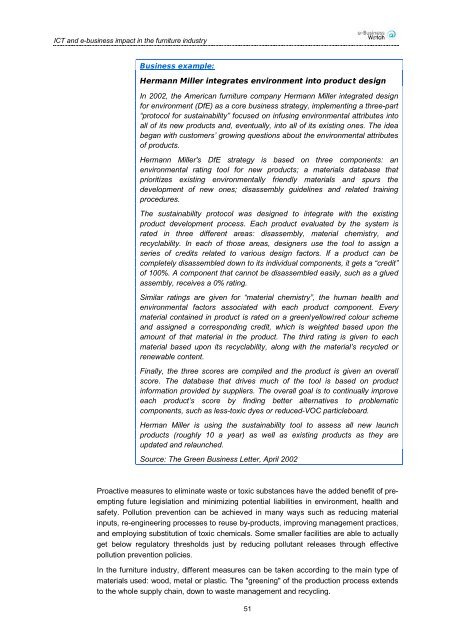ICT and e-Business Impact in the Furniture Industry - empirica
ICT and e-Business Impact in the Furniture Industry - empirica
ICT and e-Business Impact in the Furniture Industry - empirica
- No tags were found...
Create successful ePaper yourself
Turn your PDF publications into a flip-book with our unique Google optimized e-Paper software.
<strong>ICT</strong> <strong>and</strong> e-bus<strong>in</strong>ess impact <strong>in</strong> <strong>the</strong> furniture <strong>in</strong>dustry<strong>Bus<strong>in</strong>ess</strong> example:Hermann Miller <strong>in</strong>tegrates environment <strong>in</strong>to product designIn 2002, <strong>the</strong> American furniture company Hermann Miller <strong>in</strong>tegrated designfor environment (DfE) as a core bus<strong>in</strong>ess strategy, implement<strong>in</strong>g a three-part“protocol for susta<strong>in</strong>ability” focused on <strong>in</strong>fus<strong>in</strong>g environmental attributes <strong>in</strong>toall of its new products <strong>and</strong>, eventually, <strong>in</strong>to all of its exist<strong>in</strong>g ones. The ideabegan with customers’ grow<strong>in</strong>g questions about <strong>the</strong> environmental attributesof products.Hermann Miller's DfE strategy is based on three components: anenvironmental rat<strong>in</strong>g tool for new products; a materials database thatprioritizes exist<strong>in</strong>g environmentally friendly materials <strong>and</strong> spurs <strong>the</strong>development of new ones; disassembly guidel<strong>in</strong>es <strong>and</strong> related tra<strong>in</strong><strong>in</strong>gprocedures.The susta<strong>in</strong>ability protocol was designed to <strong>in</strong>tegrate with <strong>the</strong> exist<strong>in</strong>gproduct development process. Each product evaluated by <strong>the</strong> system israted <strong>in</strong> three different areas: disassembly, material chemistry, <strong>and</strong>recyclability. In each of those areas, designers use <strong>the</strong> tool to assign aseries of credits related to various design factors. If a product can becompletely disassembled down to its <strong>in</strong>dividual components, it gets a “credit”of 100%. A component that cannot be disassembled easily, such as a gluedassembly, receives a 0% rat<strong>in</strong>g.Similar rat<strong>in</strong>gs are given for “material chemistry”, <strong>the</strong> human health <strong>and</strong>environmental factors associated with each product component. Everymaterial conta<strong>in</strong>ed <strong>in</strong> product is rated on a green/yellow/red colour scheme<strong>and</strong> assigned a correspond<strong>in</strong>g credit, which is weighted based upon <strong>the</strong>amount of that material <strong>in</strong> <strong>the</strong> product. The third rat<strong>in</strong>g is given to eachmaterial based upon its recyclability, along with <strong>the</strong> material’s recycled orrenewable content.F<strong>in</strong>ally, <strong>the</strong> three scores are compiled <strong>and</strong> <strong>the</strong> product is given an overallscore. The database that drives much of <strong>the</strong> tool is based on product<strong>in</strong>formation provided by suppliers. The overall goal is to cont<strong>in</strong>ually improveeach product’s score by f<strong>in</strong>d<strong>in</strong>g better alternatives to problematiccomponents, such as less-toxic dyes or reduced-VOC particleboard.Herman Miller is us<strong>in</strong>g <strong>the</strong> susta<strong>in</strong>ability tool to assess all new launchproducts (roughly 10 a year) as well as exist<strong>in</strong>g products as <strong>the</strong>y areupdated <strong>and</strong> relaunched.Source: The Green <strong>Bus<strong>in</strong>ess</strong> Letter, April 2002Proactive measures to elim<strong>in</strong>ate waste or toxic substances have <strong>the</strong> added benefit of preempt<strong>in</strong>gfuture legislation <strong>and</strong> m<strong>in</strong>imiz<strong>in</strong>g potential liabilities <strong>in</strong> environment, health <strong>and</strong>safety. Pollution prevention can be achieved <strong>in</strong> many ways such as reduc<strong>in</strong>g material<strong>in</strong>puts, re-eng<strong>in</strong>eer<strong>in</strong>g processes to reuse by-products, improv<strong>in</strong>g management practices,<strong>and</strong> employ<strong>in</strong>g substitution of toxic chemicals. Some smaller facilities are able to actuallyget below regulatory thresholds just by reduc<strong>in</strong>g pollutant releases through effectivepollution prevention policies.In <strong>the</strong> furniture <strong>in</strong>dustry, different measures can be taken accord<strong>in</strong>g to <strong>the</strong> ma<strong>in</strong> type ofmaterials used: wood, metal or plastic. The "green<strong>in</strong>g" of <strong>the</strong> production process extendsto <strong>the</strong> whole supply cha<strong>in</strong>, down to waste management <strong>and</strong> recycl<strong>in</strong>g.51
















